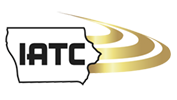Scott Cappos-University of Iowa
Teaching progression for the Discus
Bowling
The discus is released with a clockwise rotation off the index finger.
The thrower rolls the discus off the hand near the ground and focuses on the clockwise release of the implement.
Tosses
The thrower tosses the discus in the air, then adds some arm swing and the discus is released from the side of the body like an actual discus throw.
The drills are designed to teach proper release technique and develop confidence that the discus will not fall off the hand if the implement is in motion.
Standing throw
The thrower gets in the power position with the feet wider than shoulder width, the discus starts on the left side, then the discus thrower winds the discus back to 270 degrees and turns the right leg into the left side.
Standing are often completes without a reverse to emphasize the right side turning and a strong block with the left side.
½ turn throws
The thrower sets up in the middle of the circle, the right foot is placed at 9 o’clock and the upper body is facing the center of the sector, the discus is at the side of the body. The focus of the throw is an active turning the right foot, as the upper body stays back as long as possible.
Multiple ½ turn throws
The thrower completes a series of 1/2 turns then on the final ½ turn, the discus is thrown.
The discus thrower can also lean back and lift the right foot up and place it down in the middle of the ring, this adds some rhythm to the half turn throw and closely simulates the timing of the full throw.
As with the standing throws, the throw is often completed without a reverse.
Slow full throws, no reverse
The athlete executes the full technique but at a slower pace focusing on body positions. During the release phase, the discus thrower’s feet remain on the ground.
Full throws, no reverse
The throw is performed without the reverse, concentrating on turning the right side in the middle and the blocking action of the left side.
As with the slow full throws, other objects can be thrown to learn the technique without focusing on distance.
Non-throwing drills for the discus
Winding
The thrower practices the winding motion. The athlete needs to learn how to properly set up the start of the throw. This drill is works on the whole winding motion, not just winding again and again; it prepares the athlete for the next phase of the throw.
Wind and step-out
The athlete completes a wind and steps out with the right leg, tapping it on the ground at the 3 o’clock position. The left side should point at 3 o’clock with the shoulders level, the left leg will support most of the body weight (90%+).
Wind, step-out, step to the middle
The thrower completes the previous drill, then step with the right foot to the middle of the circle.
Wind, step-out, step to the middle, turn to the power position
The discus thrower adds to the previous drill by turning the right foot is in the center of the circle and the
athlete will complete the drill by finishing in the power position.
Wind, step out and turn to the power position
The thrower performs a step out, and then works on sprinting from the 3 o’clock position, landing in the power position. The drill should simulate the actual body position in the full throw, keeping very little weight on the right leg on the step out.
Turn to the power position
The athlete executes the initial throwing motion, landing in the power position. The emphasis is on balance and landing in a good throwing position with most of the body weight over the right leg.
Drills with a Throw
During each phase of the drill there is a long pause, the coach checks the positioning of the thrower, then the next phase of the drill/throw is completed.
Wind, step-out, step to the middle, turn to the power position, standing throw
Wind, step out and turn to the power position, standing throw
Turn to the power position, standing throw
Wind, step-out, step to the middle, ½ turn throw
Wind and step to the middle, ½ turn throw
Teaching Progression for the Spin
Stand throw-Spin
In the stand throw for the spin shot, the thrower gets into the power position with a narrow base; usually the feet are within the front half of the circle. The shot-putter focuses on turning then lifting with the feet, which is the opposite of the glide technique
½ turn throws
The thrower’s right foot is placed six inches past middle of the circle, the right foot is placed at 9 o’clock and the upper body is facing the center of the sector, the left arm is up and facing the center of the throwing sector. The thrower starts the throw will the right foot turning, as the upper body stays back as long as possible. The thrower turns the right side then lifts the body with both legs driving upward.
Another variation with half turn is multiple ½ turns with a throw.
As with the standing throws, the throw is often completed without a reverse.
Slow full throws
The athlete executes the full technique but a slower pace focusing on body positions, usually with lighter implements.

